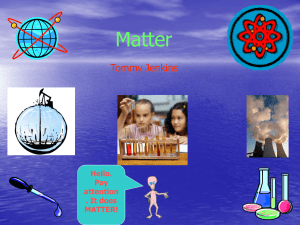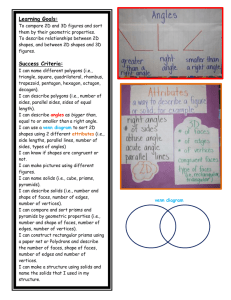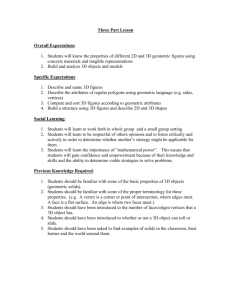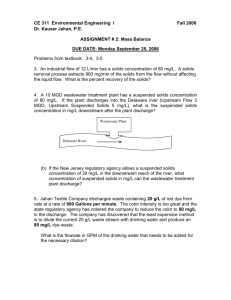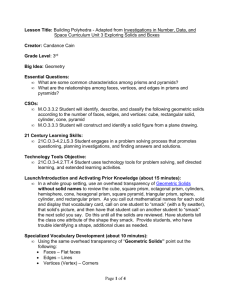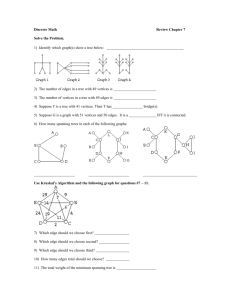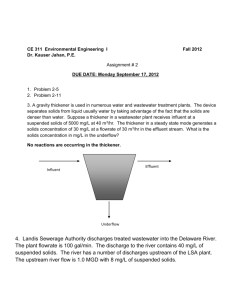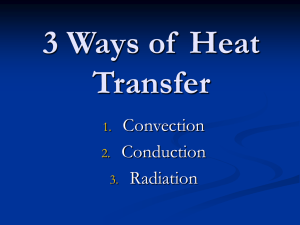Grade 2 Three Dimensional Geometry Unit Plan Sheet
advertisement
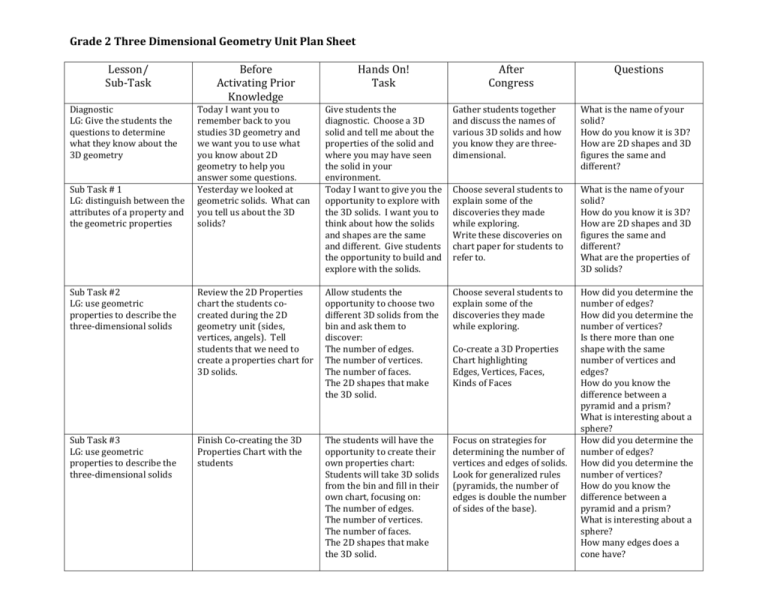
Grade 2 Three Dimensional Geometry Unit Plan Sheet Lesson/ Sub-Task Diagnostic LG: Give the students the questions to determine what they know about the 3D geometry Sub Task # 1 LG: distinguish between the attributes of a property and the geometric properties Sub Task #2 LG: use geometric properties to describe the three-dimensional solids Sub Task #3 LG: use geometric properties to describe the three-dimensional solids Before Activating Prior Knowledge Hands On! Task After Congress Today I want you to remember back to you studies 3D geometry and we want you to use what you know about 2D geometry to help you answer some questions. Yesterday we looked at geometric solids. What can you tell us about the 3D solids? Give students the diagnostic. Choose a 3D solid and tell me about the properties of the solid and where you may have seen the solid in your environment. Today I want to give you the opportunity to explore with the 3D solids. I want you to think about how the solids and shapes are the same and different. Give students the opportunity to build and explore with the solids. Gather students together and discuss the names of various 3D solids and how you know they are threedimensional. What is the name of your solid? How do you know it is 3D? How are 2D shapes and 3D figures the same and different? Choose several students to explain some of the discoveries they made while exploring. Write these discoveries on chart paper for students to refer to. What is the name of your solid? How do you know it is 3D? How are 2D shapes and 3D figures the same and different? What are the properties of 3D solids? Review the 2D Properties chart the students cocreated during the 2D geometry unit (sides, vertices, angels). Tell students that we need to create a properties chart for 3D solids. Allow students the opportunity to choose two different 3D solids from the bin and ask them to discover: The number of edges. The number of vertices. The number of faces. The 2D shapes that make the 3D solid. Choose several students to explain some of the discoveries they made while exploring. Finish Co-creating the 3D Properties Chart with the students The students will have the opportunity to create their own properties chart: Students will take 3D solids from the bin and fill in their own chart, focusing on: The number of edges. The number of vertices. The number of faces. The 2D shapes that make the 3D solid. Focus on strategies for determining the number of vertices and edges of solids. Look for generalized rules (pyramids, the number of edges is double the number of sides of the base). How did you determine the number of edges? How did you determine the number of vertices? Is there more than one shape with the same number of vertices and edges? How do you know the difference between a pyramid and a prism? What is interesting about a sphere? How did you determine the number of edges? How did you determine the number of vertices? How do you know the difference between a pyramid and a prism? What is interesting about a sphere? How many edges does a cone have? Co-create a 3D Properties Chart highlighting Edges, Vertices, Faces, Kinds of Faces Questions Sub Task #4 LG: use geometric properties to describe the three-dimensional solids Ask students what is the difference between an attribute and a property? Why don’t we describe solids by attributes? How do properties help us in mathematics? Students cut their own sort activity to help them determine the properties of the 3D solids Focus on strategies for determining the number of vertices and edges of solids. Look for generalized rules (pyramids, the number of edges is double the number of sides of the base). Sub Task #5 LG: create models and skeletons of prisms and pyramids using concrete materials and describe their geometric properties Show the students a rectangular prism made from straws and modelling clay. Place it next to a solid rectangular prism. Ask: How are these figures the same? How are they different? Which is a skeleton of a rectangular prism? Why is it called a skeleton? What parts does the skeleton show? Ask one student to come up to the front and turn their back to the students. Show the rest of the class a 3D solid. Have the student at the front of the class ask various ‘yes’ or ‘no’ questions to determine the solid. Have the students create various 3D skeletons from straws and modelling clay. Ask students to estimate how many toothpicks they will need to make a particular skeleton. Invite several students to show their skeletons to the class and explain how they constructed the skeletons. How many straws were needed to make a triangular based pyramid? How are all the skeletons alike? How are the skeletons the same as 3D solids? How are they different? Place a “What Am I” necklace around each students’ neck, with a picture of the 3D figure hanging on the student’s back. The students must try to determine the solid by asking a classmate ‘yes’ or ‘no’ questions. Have several students explain what questions they asked in order to determine the solid on their necklace. What was your first question? Why? Were there any questions that helped you to eliminate some solids? Why? Give the students the riddle: This figure has 12 edges. It has 4 long straws. It has 8 long straws. It has 8 vertices. What am I? Tell the students that they are going to give clues Play the Feely Bag Game; Place a variety of 3D solids in a paper bag. Pair students and have the student place their hand in the bag and describe the solid they pick up to their partner. Have several students explain the clues they gave to their partner to determine the mystery solid. What were useful clues? What clues were not useful? Sub Task #6 What Am I? LG: identify and describe various 3D solids and sort and classify them by their geometric properties Guide to Effective Instruction Geometry p. 133 Sub Task #7 Guess My Figure How did you determine the number of edges? How did you determine the number of vertices? How do you know the difference between a pyramid and a prism? What is interesting about a sphere? How many edges does a cone have? How many edges does a cylinder have? What was difficult in creating the solids? Which solid has the fewest edges? How many? Which solid has the most edges? How many? Which solid has edges that are all the same length? Which solids have edges that form a square (triangle, rectangle)? What did you learn about 3 dimensional solids from this task? What questions helped you to determine your solid? Could you identify your figure if you asked only one question? Why or why not? What was easy about the task? What was difficult about the task? How did you know which 3D solid you had on your necklace? What was easy about the task? What was difficult about the task? How did you know which 3D your partner was describing? Sub Task # 8 Where Does It Go? Have the students sit in a large circle. Put the 3D solids into two different piles. Ask the students to determine a sorting rule? Provide the students with a large assortment of 3D solids. Ask the students to work in pairs. Student A sorts the solids while student B tries to figure out the sorting rule. Students switch. Have several students share their sorting rules. Sub Task #9 Relative Location: describe the relative locations and the movements of objects on a map Use the Learning Carpet to model relative location. Place several item onto the Learning Carpet and have the students determine the path from one location to the other. Ensure they are using the language of left, right, up, down or the cardinal directions. Have students discuss the paths they took to get from one location to the next. Sub Task #10 Relative Location: describe the relative locations and the movements of objects on a map Play, Treasure Hunt Have one student hide a small object in the classroom. Choose a student to find the object. Ask another student to provide oral directions that will help find the hidden treasure. Put out the 3 tarps and 1 carpet for the students to explore different pathways between items they place on the carpet. One student places two items on the carpet while another student determines the most efficient path from point to the next using left, right, up down or the cardinal directions. When Colton leaves school he needs to go to the library first and then home. One the grid lines, draw the shortest path that Colton can take. Describe Colton’s path. Extension: Use the grid paper on the back to draw two different items and then find two different ways to get from point A to point B. Culminating Activity Culminating Task Common Language: Three-dimensional solids Two-dimensional shape Geometric properties Edges Vertices Faces Triangular prism Acceptable Language: forward, backwards, right, left, up, down, horizontally, diagonally, sideways, above, below, beside. Geometric Exploration Centers Assessment rectangular prism sphere cube cone vertex cylinder square based pyramid triangular based pyramid hexagonal prism Have several students explain how they got from one location to the next. Ensuring that they model prepositions. Guide to Effective Instruction p. 135 - 139 relative location cardinal directions east, west, north, south left, right, up, down horizontal, diagonal, sideways, across, above below, underneath, beside, next to What is your sorting rule? How are all these figures alike? What properties do they share? In which group should you place this figure? What other ways could you sort these figures? What was challenging about this activity? Was there more than oneway to move from one location to the other? Why can you not move diagonally? What was challenging about this activity? Was there more than oneway to move from one location to the other? Why can you not move diagonally?
